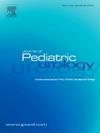Comprehensive analysis of pediatric urolithiasis in a tertiary care center and insights into demographics, risk factors, and management outcomes
IF 1.9
3区 医学
Q2 PEDIATRICS
引用次数: 0
Abstract
Background
Pediatric urolithiasis is a growing global health concern, with increasing incidence and potential risks for chronic kidney disease if untreated. Contributing factors include metabolic disorders, genetic predisposition, dietary influences, and regional variations. Despite advancements in diagnosis and treatment, management remains challenging, particularly in high-risk infants.
Objective
This study investigates the clinical characteristics, metabolic risk factors, and treatment outcomes of pediatric urolithiasis in a tertiary care center in Türkiye. Special attention is given to infants, assessing their distinct metabolic and clinical features, treatment responses, and the effectiveness of conservative management. Additionally, factors influencing stone burden and recurrence are evaluated to support individualized, risk-based management.
Methods
We retrospectively analyzed 308 children (0–18 years) diagnosed with urinary stones. Demographic data, clinical presentation, laboratory and imaging findings, treatment strategies, and outcomes were reviewed. Metabolic evaluations included urinary levels of citrate, oxalate, and calcium. Treatment approaches varied based on stone size, location, and symptoms, ranging from conservative management to medical therapy and surgical interventions.
Results
The median age at diagnosis was 12.5 months (range: 0–214), with a high prevalence of infant-onset cases. A family history of urolithiasis was present in 59.9 %, and parental consanguinity in 31.2 %. At the first visit, hypocitraturia (46.5 %), hyperoxaluria (36 %), and hypercalciuria (11.3 %) were common. Infants had higher rates of bilateral and multiple stones, while older children had larger stones (>5 mm, p < 0.001). Among infants with bilateral, multiple stones, hypocitraturia and hyperoxaluria were detected in 68.7 % and 66.1 %, respectively at follow-up, emphasizing the need for serial metabolic assessments. Nearly 70 % of patients received medical therapy, primarily Shohl's solution, while 28.2 % were managed conservatively. Among those with stones ≤5 mm, one-third were observed without intervention, with no significant difference in stone-free rates. Surgical interventions included extracorporeal shock wave lithotripsy (21.8 %), percutaneous nephrolithotomy (8.8 %), ureterorenoscopy (12.3 %), and open surgery (2.3 %).
Discussion
Comparable stone-free rates between treated and untreated small stones (≤5 mm) support the role of conservative management in selected cases without metabolic risk factors. However, the high rate of surgical interventions highlights the need for individualized treatment. Early-onset urolithiasis is frequently bilateral and multiple, reinforcing the importance of serial urine testing for accurate diagnosis.
Conclusion
Pediatric urolithiasis generally has a favorable prognosis with early diagnosis and tailored management. High-risk infants require proactive metabolic evaluation and long-term follow-up, as metabolic abnormalities may not be present at initial diagnosis. These findings support a risk-based, individualized approach to pediatric urolithiasis management.
综合分析儿科尿石症在三级保健中心和洞察人口统计学,危险因素,和管理结果。
背景:儿童尿石症是一个日益增长的全球健康问题,如果不治疗,慢性肾脏疾病的发病率和潜在风险不断增加。影响因素包括代谢紊乱、遗传易感性、饮食影响和地区差异。尽管在诊断和治疗方面取得了进步,但管理仍然具有挑战性,特别是在高危婴儿中。目的:本研究探讨基伊省某三级保健中心儿童尿石症的临床特点、代谢危险因素和治疗结果。特别关注婴儿,评估他们独特的代谢和临床特征,治疗反应和保守管理的有效性。此外,评估影响结石负担和复发的因素,以支持个体化、基于风险的管理。方法:回顾性分析308例0 ~ 18岁诊断为尿路结石的儿童。我们回顾了人口统计资料、临床表现、实验室和影像学结果、治疗策略和结果。代谢评估包括尿中柠檬酸盐、草酸盐和钙的水平。治疗方法因结石大小、位置和症状而异,从保守治疗到药物治疗和手术干预。结果:诊断时的中位年龄为12.5个月(范围:0-214),婴儿发病病例的患病率很高。有尿石症家族史的占59.9%,有亲本血缘关系的占31.2%。首次就诊时,低尿症(46.5%)、高草酸尿症(36%)和高钙尿症(11.3%)较为常见。婴儿有较高的双侧和多发性结石的发生率,而年龄较大的儿童有较大的结石(bbb5毫米,p讨论:治疗和未治疗的小结石(≤5毫米)的结石无结石率比较支持在没有代谢危险因素的选定病例中保守治疗的作用。然而,手术干预的高比率突出了个体化治疗的必要性。早发性尿石症通常是双侧和多发的,这加强了连续尿液检测对准确诊断的重要性。结论:小儿尿石症的早期诊断和治疗具有良好的预后。高危婴儿需要积极的代谢评估和长期随访,因为初始诊断时可能不存在代谢异常。这些发现支持以风险为基础的个体化儿科尿石症治疗方法。
本文章由计算机程序翻译,如有差异,请以英文原文为准。
求助全文
约1分钟内获得全文
求助全文
来源期刊

Journal of Pediatric Urology
PEDIATRICS-UROLOGY & NEPHROLOGY
CiteScore
3.70
自引率
15.00%
发文量
330
审稿时长
4-8 weeks
期刊介绍:
The Journal of Pediatric Urology publishes submitted research and clinical articles relating to Pediatric Urology which have been accepted after adequate peer review.
It publishes regular articles that have been submitted after invitation, that cover the curriculum of Pediatric Urology, and enable trainee surgeons to attain theoretical competence of the sub-specialty.
It publishes regular reviews of pediatric urological articles appearing in other journals.
It publishes invited review articles by recognised experts on modern or controversial aspects of the sub-specialty.
It enables any affiliated society to advertise society events or information in the journal without charge and will publish abstracts of papers to be read at society meetings.
 求助内容:
求助内容: 应助结果提醒方式:
应助结果提醒方式:


